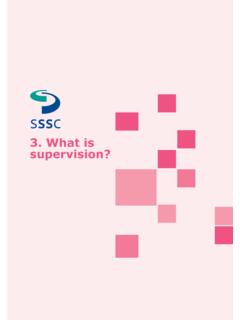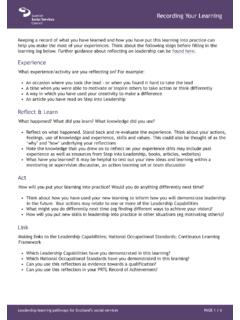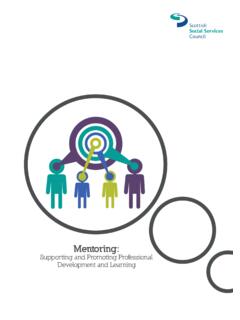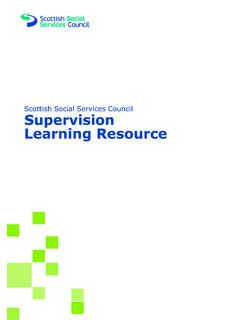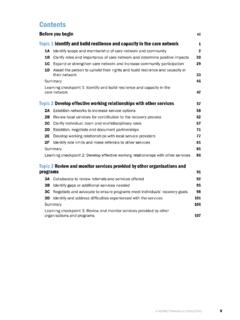Transcription of 1. What is coaching and how can it be used?
1 coaching Learning Resource 71. What is coaching and how can it be used? 8 coaching Learning ResourceIn this section we cover:1. what is coaching and why it is useful in social services2. how a coaching approach can be used in different ways 3. what is involved in an informal coaching approach. After reading this section you will be able to: describe what is involved in coaching and how it can be used show what coaching in practice looks like in the social service context consider what the potential roles in coaching might mean for your own What is coaching and why it is useful in social servicesWhat is coaching ? coaching is a developmental approach to working and interacting with other people.
2 It can help people develop their personal capabilities, interpersonal skills and capacity to understand and empathise with others. In turn, this can help people understand more about their own challenges and make informed choices about their future. It can strengthen their ability to use a range of influencing and leadership styles. coaching can help people feel more empowered to make a difference and improve their own effectiveness. We believe that coaching is a practical strategy that helps someone achieve outcomes they identify themselves. The outcomes may be about perceptions and beliefs as well as about observable behaviour and concrete action. coaching leads to insight, discovery and forward movement, in alignment with the uniqueness of the individual, their understanding of the world, values and preferences.
3 Relationship is the foundation of its success. (Jenny Bird and Sarah Gornall, 2016, p13)Why is coaching useful in social services?The vision for Scotland s social services is for:.. a socially just Scotland with excellent social services delivered by a skilled and valued workforce which works with others to empower, support and protect people, with a focus on prevention, early intervention and enablement. (Scottish Government, 2015, p7)Delivering this vision means supporting people using services to develop their personal capabilities so they are able to exercise their citizen leadership to best effect (Scottish Government, 2008). It means having a workforce with the interpersonal skills and leadership capabilities to work with different people in different ways.
4 coaching Learning Resource 9It means developing the culture across social services so people feel valued, empowered, enabled, inspired, motivated and able to see and take opportunities to do things differently. It means making sure the culture continues to be supported by the core social service values of: promoting enablement and participation understanding each individual in the context of family and community identifying and building on the strengths of individuals and communities. (Scottish Government, 2015, p11)If lots of people across social services are using a coaching approach more often this will start to have a broader impact on service and organisational culture. A culture in which people listen, demonstrate care and compassion, stay open to others perspectives and new possibilities is consistent with the achievement of Social Services in Scotland a shared vision and strategy 2015 2020 (Scottish Government, 2015).
5 The development of a coaching culture will also enable individuals to develop their own capacity to self-coach. Organisations wishing to maximise the benefits of coaching should focus on increasing its scope and availability to create a coaching culture that permeates throughout their workforce. This means that coaching must be supported at the very top of the organisation, but not limited to senior executives, and that organisations need to devote resources to developing their internal coaching capability. (Institute of Leadership and Management, 2011, p2)The typical benefits of coaching for individuals include: improvements in communication and interpersonal skills development of leadership and management capabilities finding sustainable solutions to personal and work-related issues enhanced capacity to resolve conflict positive changes in attitudes and motivation increased personal confidence improved management performance feeling more engaged, valued and supported feeling more prepared for a change in role or organisational coaching Learning How a coaching approach can be used in different waysA coaching approach can be used in different ways ranging from informal to more formal as shown in diagram A.
6 It can take place between two people or in groups of people. Diagram A: Range of uses of coachingAn informal coaching conversation between two people or a group of peopleWe can use a coaching approach informally for better conversations between people using services and between colleagues who work in social services. If you want to support others and yourself to step back and see things differently, you might consider using a coaching conversation. The purpose of a coaching conversation is to encourage thinking and reflection. It can create the opportunity for people to see things from a fresh perspective. This can help them develop their capabilities, make sense of their situation and make clear choices about what to do next.
7 A coaching conversation has different qualities to everyday social or work based conversations. It differs in the quality of the listening and the space it provides for those involved. The quality of this space can help people make sense of their situation and make clear choices about what to do next. It requires listening to each other more intently, using open questions and avoiding jumping too quickly to our own conclusions. In this way, you will help the other person see their situation more clearly. It means staying open for longer to the possibilities being explored in the conversation rather than simply sticking to our own point of view. It means being able to recognise the difference between what is actually being said and our perceptions or assumptions about what is being said (or not).
8 It can help groups of people work more collaboratively and come up with new approaches Learning Resource 11 Example of using informal coaching A group of people working in social services want to find new ways of managing and developing a particular service. They decide to use a number of group coaching conversations. Through their coaching conversations, the group is able to step back from their current situation and develop new insights. The space for reflection helps them to identify some improvements and make choices about new ways of informal coaching approach between line manager and workerManagers and workers in social services can make their working relationships more effective if they use a coaching approach.
9 A line manager can enable a worker to identify their own issues and come up with their own solutions rather than imposing solutions on them by having coaching conversations. Central to a coaching approach is providing timely, clear and specific feedback. A coaching conversation is unlike most other discussions. It involves an unusually high level of trust and candour on both sides. (Jenny Rogers, 2004, p27)Leaders at all levels of social services use coaching as one of a range of leadership styles A coaching approach to leadership means the leader s focus is on enabling other people to develop their capabilities and find their own solutions. It means listening more and trying to understand points of view rather than imposing your own views and approaches.
10 coaching can also provide valuable support and challenge to people who are in formal and/or informal leadership roles by helping them explore their issues and concerns in a safe, supportive is a clear link between using a coaching approach in leadership and the lead-ership capabilities outlined in the Strategy for developing leadership capacity in Scot-land s social services, 2013-2015 (Scottish Social Services Council, 2014).Formal coachingFormal coaching can be used for learning, development or performance improvement. The purpose of the coaching is agreed between the person being coached (coachee) and their coach. The coach discusses and agrees a contract with the coachee, which includes the focus or purpose of the coaching , the coaching process and how the boundaries around the coaching will be coaching Learning ResourceIt can be one-to-one between a coachee and an internal coach working in social services who has undertaken formal development as a coach.
